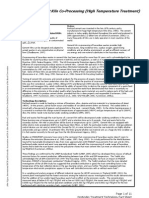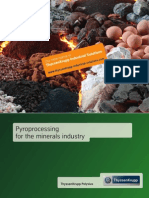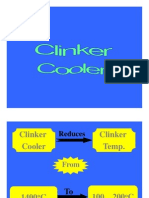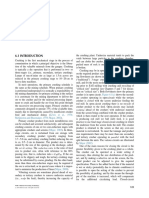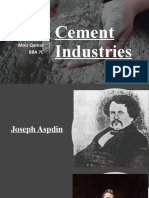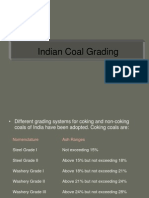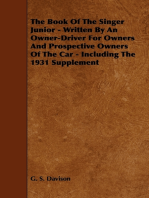Enhance The Performance of Tube Grinding Mills: Let Us Employ Grinding Rollers
Enhance The Performance of Tube Grinding Mills: Let Us Employ Grinding Rollers
Uploaded by
D S VenkateshCopyright:
Available Formats
Enhance The Performance of Tube Grinding Mills: Let Us Employ Grinding Rollers
Enhance The Performance of Tube Grinding Mills: Let Us Employ Grinding Rollers
Uploaded by
D S VenkateshOriginal Title
Copyright
Available Formats
Share this document
Did you find this document useful?
Is this content inappropriate?
Copyright:
Available Formats
Enhance The Performance of Tube Grinding Mills: Let Us Employ Grinding Rollers
Enhance The Performance of Tube Grinding Mills: Let Us Employ Grinding Rollers
Uploaded by
D S VenkateshCopyright:
Available Formats
Enhance the performance of Tube grinding mills:
Let us employ Grinding Rollers
D.S. Venkatesh,
Freelance Tech. Consultant, Bangalore
Compression grinding employing rollers as grinding elements has become the wayleading to specific
energy values markedly lower than those obtained in ballmilling plants in cement and mineral processing
industries all over the world.Here are some novel ways, other than conventional, to re-engineer the existing
ball milling plants to employ Rollers as grinding elements for enhancing the productivity.
1.0 Introduction:
In short, of well known compression grinding machines, in HPGR roller presses, the bed thickness will be
low, speed has to be limited to below 1.5 m/sec because of vibrations, and nip angle is around 6 degrees. In
Vertical Roller mills, speed is limited by centrifugation of material, nip is around 12 degrees and bed depth
is medium. In the latest Beta Mills, by having defined feeding velocity, material height and width, a defined
layer of homogeneous pre-aired material will be fed to the grinding zone assuring perfect utilization of the
employed energy in the grinding process.
In all these cases, more than one roller is employed. Horomill employs only one grinding roller under
medium pressure functioning within a rotating shell... Communition will be by multiple compressions. The
conjugate concave and convex geometries of the grinding surfaces lead to angles of nip two or three times
higher than in roll presses, which lead to a thicker ground layer and a more important grinding work.
Multiple compression permits to vary the circulating load for same finished product to achieve the required
size distribution. The mill is less sensitive to feed size distribution. In view of shell size limitation, higher
production rate calls for multiple units.
The main advantage of Shell roller grinding mills (SRG Mills) is wide flexibility of operating mill speed.
Conventional tube mills have limitations as regards the mill speed, and usually function at speeds around
75 to 78 percent critical speed. With roller as grinding element inside the mill shell, the upper value of
speed is not critical, and can be run either at sub-critical or super critical speeds, as required. Here are some
novel ways, other than conventional, to re-engineer the existing ball milling plants to employ Rollers as
grinding elements for enhancing productivity.
2.0 Re-engineer to function as SRG Mill:
Incorporate Grinding roller in tube mill. This converts the mill to function as shell roller grinding mill
(SRG Mill). Each chamber can be treated as a unit and grinding roller incorporated in one or all the
chambers. From mechanical point of view, the Shell Roller Mill combines proven elements of ball mill and
elements akin to roll press but with much lower grinding pressures. The material advances regularly in the
mill thanks to the combined effects of centrifugal force and passes several times between the roller and the
shell to be ground there. Grinding is achieved in several steps viz., multiple compression. Pressing pressure
of grinding roll, bed thickness and speed are the three operational parameters that govern the circulating
load, fineness of grind, particle size distribution, output and power consumption. All shell roller grinding
mills can be run at sub-critical or super-critical speeds in excess of conventional ball or rod mills. The
greater peripheral speed of mill shell increases the amount of material ground in direct proportion, but only
if the material ground is promptly removed from the grinding chamber. Various measures for applying the
grinding force on the roller have resulted in several configurations. These measures may be, to cite a few,
multiple co-axial rolls, magnetic biasing of rollers, magnetic lining of mill shell, mechanical or hydraulic
means of applying the pressure on rolls. Also, the horizontal roller mills can be of two broad categories:
Shell driving the rollers or Rollers driving the Shell by frictional contact.
3.0 Simple SRG Mill:
The simplest mill has a large diameter roller freely revolving in contact with the mill shell. The weight of
the grinding roller will be sufficient enough to rest vertically downwards in contact with the mill shell
lining. Material is fed through the trunnion as usual, and ground material is air-swept out of the mill,
alternatively by grate/end discharge. The roller diameter determines the line pressure and along with its
length, the weight of grinding element. It is desirable to have vertical grooved liners, with ridges, as this
will allow material to flow through avoiding building up on one side of the roller only. Moreover, the roller
may be made slightly conical and the shell fitted with conical lining. This improves material flow towards
the discharge end.
4.0 SRG Mill with Pressure Rollers:
Another alternative is to provide one or more fixed grinding rollers disposed radially within the mill shell
and supported by a fixed shaft which extends along the axis of rotation, each of said rollers being idle and
above to rotate by friction within the inner wall of the mill shell. The average pressure exerted by the roller
on the material during grinding is between 10 and 40 MPa. The material tends to occupy a determined zone
of the inner chamber of the mill shell which depends upon the particle size and on the speed of rotation of
the mill, which must be slow enough not to produce centrifuging. In view of this, the power consumption is
reduced to as low as 60 percent of that of tube mill
5.0 SRG Mill with simultaneous planetary grinding:
Fit the mill shell with Planetary Lining. Each liner will have a central circular hallow core. When the liners
are fitted, the combination will form centrifugal tubes at the inner circumference of the shell. While the
feed is reduced first by the roller, subsequent material enters the planetary tubes in the shell for
simultaneous centrifugal grinding. The planetary tubes shall have either large dia rod or conventional
grinding media. The PSRG mill can be run at higher speeds and the required fineness and output can be
obtained without recourse to classification. Air is sucked through the planetary tubes for venting the mill.
Planetary shell roller grinding mills are usually operated at super-critical speeds.
6.0 Incorporate a Pre-grinding Roll:
The supporting roller from a rotary kiln or dryer can be gainfully adopted to serve as the grinding roller.
Necessary hard facing can be carried out to withstand the wear during operations. The riding ring needs to
be split type and fixed to the mill shell over shoe plates to serve as the larger drive roller. The grinding
roller is mounted in the 90 to 180 deg quadrant touching the top surface of the riding ring and the feed
hopper is arranged in the 0 to 90 deg quadrant when looking the direction of rotation, as shown in the
figure. The riding ring is located usually directly above the first diaphragm of the mill The effective width
of the riding ring/supporting roller and the bed depth determines the throughput as the mill speed is usually
fixed around 75 to 80 percent critical speed. The pressing force of grinding roller can be hydraulically
adjusted depending upon the material ground.
7.0 Re-engineering of Existing mils:
Re-engineering of existing media mill to function as SRG Mill will be economical than additional
installation of either a separate Pre-grinder, High pressure grinding rolls or Vertical Roller Pre-grind Mills,
since the roller set up will be integrated with the existing mill and no additional equipment foundations,
buildings, or civil engineering works are required.
Air swept Coal mills, being single compartment and already having air sweeping arrangement for
ground material carry over outside the mill, will become the apt choice.
In case of two compartment raw mills with end diaphragm discharge, the first compartment may
be re-engineered for pre-grinding and the second compartment for finish grinding. In case of
intermediate discharge arrangement, both the compartments may be re-engineered for finish
grinding simultaneously.
In case of three compartment mills, the first compartment may be employed for Pre-grinding, the
second for grinding and the third for finish grinding of material.
The extent of capacity increase and possible reduction in specific power consumption will much depend
upon roller configuration within the mill shell, number of compartments and more than all on the practical
measure employed how the grinding force is exerted on the roll surface. Each case has to be customized for
achieving best possible enhancement in performance of the re-engineered mill.
For Re-engineering, please contact:
D.S. Venkatesh,
Freelance Tech. Consultant,
# 105, Seventh Cross, Blekahalli Dollar Layout,
B T M 2nd Stage, Bangalore 560076
Phone: 91 080 26688098 E-mail: dsvenkatesh40@yahoo.com
E-mail: dsvenkatesh40@gmail.com
You might also like
- FLS Kiln Systems MechanicalDocument17 pagesFLS Kiln Systems MechanicalKiarash NiroumandNo ratings yet
- Thesis Final About Lime KilnsDocument144 pagesThesis Final About Lime KilnspwmvsiNo ratings yet
- A TEC Leaflet HURRICLON PDFDocument2 pagesA TEC Leaflet HURRICLON PDFthanh100% (1)
- To: The Production Manager: Sub: Raw Mill Run Without Kiln Dear: SirsDocument2 pagesTo: The Production Manager: Sub: Raw Mill Run Without Kiln Dear: SirsMohammed AbdoNo ratings yet
- Paper Darab Cement Kiln SealDocument11 pagesPaper Darab Cement Kiln Sealomid1302No ratings yet
- Cement, It's Properties, Tests, Types of CementDocument40 pagesCement, It's Properties, Tests, Types of CementNamrata PalNo ratings yet
- Combustion & FuelsDocument49 pagesCombustion & FuelsRAJESH KUMAR100% (1)
- UnitDocument78 pagesUnitMohammed Khalid HakeemNo ratings yet
- Applications Steel: Plexicoke in The VmezuelanDocument8 pagesApplications Steel: Plexicoke in The VmezuelanJose Marval RodriguezNo ratings yet
- Cement Kiln Co-ProcessingDocument11 pagesCement Kiln Co-ProcessingflukemonsterNo ratings yet
- Cooling TowerDocument3 pagesCooling Toweradearyani4No ratings yet
- High-Pressure Grinding Roller Presses For Minerals ProcessingDocument24 pagesHigh-Pressure Grinding Roller Presses For Minerals ProcessingYaser Asmani100% (1)
- Shree Project FinalDocument20 pagesShree Project FinalMostafa KordyNo ratings yet
- Process Control of LURM MillDocument6 pagesProcess Control of LURM Millimam janiNo ratings yet
- Substitution of Charcoal For Coke Breeze in Iron Ore SinteringDocument10 pagesSubstitution of Charcoal For Coke Breeze in Iron Ore SinteringWastek 19No ratings yet
- Clinker IzationDocument30 pagesClinker Izationamaralinga chariNo ratings yet
- Vibration312 PDFDocument3 pagesVibration312 PDFkakaNo ratings yet
- Pyroprocessing For The Minerals Industry: Rupp Industrial SolutionsDocument8 pagesPyroprocessing For The Minerals Industry: Rupp Industrial SolutionsawfahaddadinNo ratings yet
- Fls - Cfi SiloDocument4 pagesFls - Cfi SiloNicolás CanelliNo ratings yet
- Vertical Roller Mill State of The Art Raw GrindingDocument4 pagesVertical Roller Mill State of The Art Raw GrindingzementheadNo ratings yet
- OCL Bengal Cement WorksDocument35 pagesOCL Bengal Cement WorksswarupkumarnayakNo ratings yet
- Tube MillsDocument44 pagesTube MillsRodrigo AlcainoNo ratings yet
- Brochure 154 Loesche-Mills For Cement Raw Material EN PDFDocument24 pagesBrochure 154 Loesche-Mills For Cement Raw Material EN PDFMohammed AbdoNo ratings yet
- Schenck WebDocument4 pagesSchenck Webarief22No ratings yet
- Importance of Dedusting Pipe LayoutDocument4 pagesImportance of Dedusting Pipe LayoutManoj ThakurNo ratings yet
- Bulletin 9 - CFD Analysis and Flow Smoothening in PH Down Comer Duct To Reduce Pressure DropDocument2 pagesBulletin 9 - CFD Analysis and Flow Smoothening in PH Down Comer Duct To Reduce Pressure DropSivaram KrishnamoorthyNo ratings yet
- FK Pump and FV Compressor - BrochureDocument8 pagesFK Pump and FV Compressor - BrochureJohn Lester Padilla-DacanayNo ratings yet
- VRM Roller Bearing FailureDocument39 pagesVRM Roller Bearing FailureReda M.SalemNo ratings yet
- Application of GGBS in ChinaDocument10 pagesApplication of GGBS in ChinaNuno FerreiraNo ratings yet
- Assiut Cement PlantDocument17 pagesAssiut Cement PlantMahmoud RashadNo ratings yet
- 3.4 - Burning in A KilnDocument4 pages3.4 - Burning in A KilnIrshad Hussain100% (1)
- Ion Tube Mill and Bowl MillDocument6 pagesIon Tube Mill and Bowl MillDevendra PrasadNo ratings yet
- Vibrating MillDocument6 pagesVibrating MillJorge Alexander Rocha Alvarez100% (1)
- SNT Plummer Block CatalogDocument120 pagesSNT Plummer Block CatalogRickson PhilipNo ratings yet
- 1 Exemplary Technical Report 2012 PDFDocument99 pages1 Exemplary Technical Report 2012 PDFMKPashaPashaNo ratings yet
- Life Is Full of Challenges So Be Brave & Face ItDocument48 pagesLife Is Full of Challenges So Be Brave & Face Itrams221209No ratings yet
- CementmaterilsDocument33 pagesCementmaterilsengineeringchemistry100% (1)
- Grinding and Milling in Cement Manufacturing: 1.2 Fineness RequirementsDocument6 pagesGrinding and Milling in Cement Manufacturing: 1.2 Fineness RequirementsJosé UrdayNo ratings yet
- Chapter 1&2 Introduction & CentrifugationDocument39 pagesChapter 1&2 Introduction & Centrifugationulfh08152100% (1)
- Vertical Roller Mill IntroductionDocument2 pagesVertical Roller Mill Introductionemad sabriNo ratings yet
- Clinker Cooler TypesDocument17 pagesClinker Cooler Typesemad sabri100% (2)
- Fem in Rotary KilnDocument7 pagesFem in Rotary KilnDuabelasyusufNo ratings yet
- Cyclon 5 BlockageDocument9 pagesCyclon 5 BlockageHamed MostafaNo ratings yet
- The Effect of Partial Replacement of Cement With Kaolin Powder in The Production of C-25 ConcreteDocument8 pagesThe Effect of Partial Replacement of Cement With Kaolin Powder in The Production of C-25 ConcreteHunde HailuNo ratings yet
- Crushers: Wills' Mineral Processing Technology. © 2016 Elsevier Ltd. All Rights ReservedDocument24 pagesCrushers: Wills' Mineral Processing Technology. © 2016 Elsevier Ltd. All Rights ReservedDanny Joaquin Flores CruzNo ratings yet
- Chapter 1Document56 pagesChapter 1Surbhi JainNo ratings yet
- Supervisory Fuzzy Control of A Rotary Cement KilnDocument4 pagesSupervisory Fuzzy Control of A Rotary Cement KilnJohn GiannakopoulosNo ratings yet
- 2 200901loeschetadipatri 120803014722 Phpapp01Document4 pages2 200901loeschetadipatri 120803014722 Phpapp01Sai Sricharan ReddyNo ratings yet
- 12 Mr. Christensen, Nosering Case StoryDocument20 pages12 Mr. Christensen, Nosering Case StoryJunaid MazharNo ratings yet
- The Economics of HardfacingDocument6 pagesThe Economics of Hardfacingemad sabri100% (1)
- FLSmidth SF Cooler UpgradeDocument2 pagesFLSmidth SF Cooler UpgradeMohammed AbdoNo ratings yet
- Vertical Roller Mill UpgradeDocument2 pagesVertical Roller Mill UpgradeBülent BulutNo ratings yet
- Bush Type CouplingDocument2 pagesBush Type CouplingSandeep PrajapatiNo ratings yet
- 02 PCRA NitendraDewanganDocument127 pages02 PCRA NitendraDewanganGovind RaoNo ratings yet
- Cement Industries: Sarah Khan Mahgul Kharo Moiz Qamar Bba 7CDocument67 pagesCement Industries: Sarah Khan Mahgul Kharo Moiz Qamar Bba 7CMoiz QamarNo ratings yet
- Chemical CharacterisationDocument66 pagesChemical Characterisationvenkatakrishna chalapaathiNo ratings yet
- The Purpose of A Cooler Is, Obviously To Cool The Clinker - This Is Important For A Several ReasonsDocument31 pagesThe Purpose of A Cooler Is, Obviously To Cool The Clinker - This Is Important For A Several ReasonsZegera MgendiNo ratings yet
- ACCUMULATORS Part-A Question and AnswersDocument10 pagesACCUMULATORS Part-A Question and Answerssar_tpgitNo ratings yet
- The Book of the Singer Junior - Written by an Owner-Driver for Owners and Prospective Owners of the Car - Including the 1931 SupplementFrom EverandThe Book of the Singer Junior - Written by an Owner-Driver for Owners and Prospective Owners of the Car - Including the 1931 SupplementNo ratings yet
- CemengPSRG Grinding MillsDocument4 pagesCemengPSRG Grinding MillsJason GarzaNo ratings yet
- Enhance The Performance of Tube Grinding Mills: Install Satellite Grinding Tubes Over Existing Mill ShellDocument2 pagesEnhance The Performance of Tube Grinding Mills: Install Satellite Grinding Tubes Over Existing Mill ShellD S VenkateshNo ratings yet
- Horizantal Rotary Cascade PreheaterDocument3 pagesHorizantal Rotary Cascade PreheaterD S VenkateshNo ratings yet
- Let Us Employ SRG and PSRG TechnologyDocument1 pageLet Us Employ SRG and PSRG TechnologyD S VenkateshNo ratings yet
- D.S. Venkatesh: Subject: Doubble Up Product Output From Ball Mills by PSRG Milling TechnologyDocument1 pageD.S. Venkatesh: Subject: Doubble Up Product Output From Ball Mills by PSRG Milling TechnologyD S VenkateshNo ratings yet
- Cemeng Dragon CalcinerDocument3 pagesCemeng Dragon CalcinerD S VenkateshNo ratings yet
- Cemeng Mediagrinding Classifier MillsDocument6 pagesCemeng Mediagrinding Classifier MillsD S VenkateshNo ratings yet









